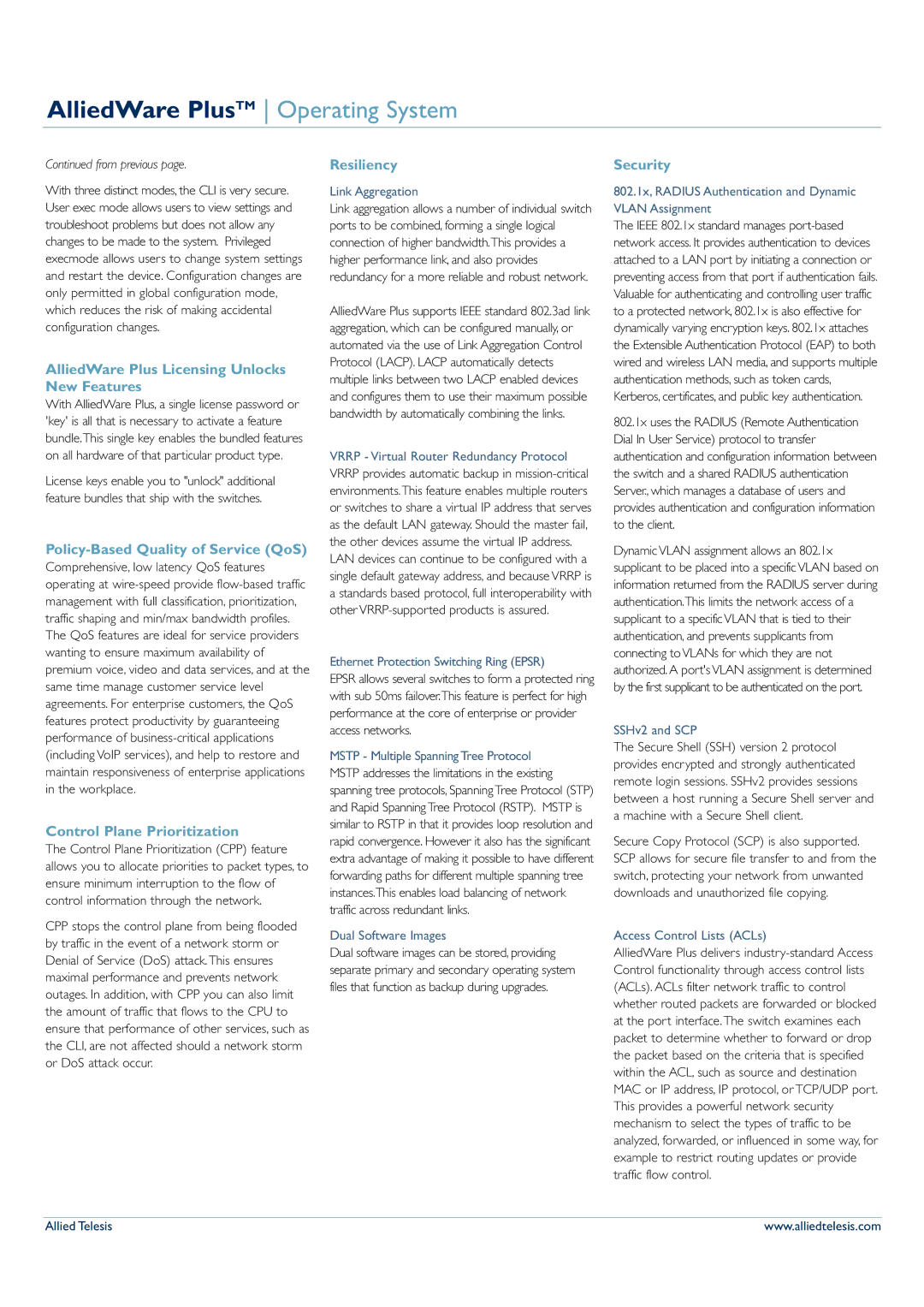
AlliedWare PlusTM Operating System
Continued from previous page.
With three distinct modes, the CLI is very secure. User exec mode allows users to view settings and troubleshoot problems but does not allow any changes to be made to the system. Privileged execmode allows users to change system settings and restart the device. Configuration changes are only permitted in global configuration mode, which reduces the risk of making accidental configuration changes.
AlliedWare Plus Licensing Unlocks New Features
With AlliedWare Plus, a single license password or 'key' is all that is necessary to activate a feature bundle.This single key enables the bundled features on all hardware of that particular product type.
License keys enable you to "unlock" additional feature bundles that ship with the switches.
Policy-Based Quality of Service (QoS)
Comprehensive, low latency QoS features operating at
Control Plane Prioritization
The Control Plane Prioritization (CPP) feature allows you to allocate priorities to packet types, to ensure minimum interruption to the flow of control information through the network.
CPP stops the control plane from being flooded by traffic in the event of a network storm or Denial of Service (DoS) attack.This ensures maximal performance and prevents network outages. In addition, with CPP you can also limit the amount of traffic that flows to the CPU to ensure that performance of other services, such as the CLI, are not affected should a network storm or DoS attack occur.
Resiliency
Link Aggregation
Link aggregation allows a number of individual switch ports to be combined, forming a single logical connection of higher bandwidth.This provides a higher performance link, and also provides redundancy for a more reliable and robust network.
AlliedWare Plus supports IEEE standard 802.3ad link aggregation, which can be configured manually, or automated via the use of Link Aggregation Control Protocol (LACP). LACP automatically detects multiple links between two LACP enabled devices and configures them to use their maximum possible bandwidth by automatically combining the links.
VRRP - Virtual Router Redundancy Protocol VRRP provides automatic backup in
Ethernet Protection Switching Ring (EPSR)
EPSR allows several switches to form a protected ring with sub 50ms failover.This feature is perfect for high performance at the core of enterprise or provider access networks.
MSTP - Multiple Spanning Tree Protocol MSTP addresses the limitations in the existing spanning tree protocols, Spanning Tree Protocol (STP) and Rapid Spanning Tree Protocol (RSTP). MSTP is similar to RSTP in that it provides loop resolution and rapid convergence. However it also has the significant extra advantage of making it possible to have different forwarding paths for different multiple spanning tree instances.This enables load balancing of network traffic across redundant links.
Dual Software Images
Dual software images can be stored, providing separate primary and secondary operating system files that function as backup during upgrades.
Security
802.1x, RADIUS Authentication and Dynamic VLAN Assignment
The IEEE 802.1x standard manages
802.1x uses the RADIUS (Remote Authentication Dial In User Service) protocol to transfer authentication and configuration information between the switch and a shared RADIUS authentication Server., which manages a database of users and provides authentication and configuration information to the client.
Dynamic VLAN assignment allows an 802.1x supplicant to be placed into a specific VLAN based on information returned from the RADIUS server during authentication.This limits the network access of a supplicant to a specific VLAN that is tied to their authentication, and prevents supplicants from connecting to VLANs for which they are not authorized. A port's VLAN assignment is determined by the first supplicant to be authenticated on the port.
SSHv2 and SCP
The Secure Shell (SSH) version 2 protocol provides encrypted and strongly authenticated remote login sessions. SSHv2 provides sessions between a host running a Secure Shell server and a machine with a Secure Shell client.
Secure Copy Protocol (SCP) is also supported. SCP allows for secure file transfer to and from the switch, protecting your network from unwanted downloads and unauthorized file copying.
Access Control Lists (ACLs)
AlliedWare Plus delivers
Allied Telesis | www.alliedtelesis.com |
